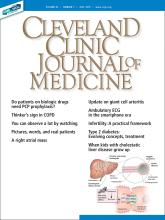Article Figures & Data
Figures
Tables
Diagnosis Unexplained palpitations Unexplained syncope Cryptogenic stroke Prognosis Hypertrophic cardiomyopathy Arrhythmogenic right ventricular dysplasia Wolff-Parkinson-White syndrome Primary arrhythmic diseases Arrhythmia treatment assessment Atrial fibrillation “Pill-in-the-pocket” After antiarrhythmic therapy Postablation Backwards memory—Records data captured before patient activation Full disclosure—Provides arrhythmia data from the entire recording period Looping memory—Records over previously captured data, saving only what is pertinent, which reduces the need for extra memory capacity Multichannel—Records electrocardiographic signals from 2 or more leads simultaneously Post-event monitor—Recording activated by the patient when an event occurs Telemetry transmission—Continuously transmits data to a manned remote monitoring station Wearable device—Electronic device incorporated into a traditional form (eg, smartwatch) that can easily be worn Device Design Duration Indications Advantages Limitations Cost Holter monitor 3–12 leads attached by wires
Data are uploaded after recording is complete24–48 hours continuously Palpitations, syncope, or presyncope when symptoms occur nearly daily
Silent arrhythmia that occurs frequently or to assess for arrhythmia recurrence after therapyContinuous recording
Full disclosure
Up to 12 leads
Physician familiarityShort duration
Post hoc analysis
Uses wires and gel electrodes$ Post-event recorder Leadless held to the chest during symptoms
Real-time transmission of data for analysisUp to 30 days intermittently Infrequent symptoms (eg, palpitations) that are not debilitating Extended observation
Real-time data transmissionRecords only selected sequences
Requires patient activation$ External loop recorder 3–12 leads attached by wires
Records when triggered by patient or arrhythmiaUp to 30 days; continuous observation and intermittent recording Infrequent symptoms or suspected infrequent silent arrhythmia Extended recording
Automated arrhythmia analysis
Multichannel acquisition
Backwards memoryRecords only selected sequences
Uses wires and gel electrodes$$ Implantable loop recorder Implanted subcutaneously in the left parasternal region Up to 3 years; continuous observation and intermittent recording Very infrequent symptoms
Suspected paroxysmal atrial fibrillation in cryptogenic strokeVery long observation
Automated arrhythmia analysisRecords only selected sequences
Requires surgical insertion
High cost$$$$ Mobile cardiac telemetry 3 leads attached by wires
Communicates with portable monitor and real-time transmission for analysis1–4 weeks continuously Suspected high-risk arrhythmia (eg, ventricular tachycardia) that can be identified and addressed in real time
After starting new antiarrhythmic drugContinuous and extended recording
Real-time rhythm analysis and responseRequires significant manpower for monitoring
High up-front cost for device$$$ Patch monitor Affixed to the left pectoral region
Some have real-time telemetry, others require later data analysis2–4 weeks continuously Moderate frequency symptoms or suspected low-risk asymptomatic arrhythmia Continuous recording
Full disclosure
Ergonomic design increases patient adherenceSingle channel
Needs post hoc analysis$$ Smart- tech ECG Fingers are placed on an external sensor
Generates a single- lead electrocardiogram on the phone or watch screen30 seconds intermittently Intermittent, low-risk, nondebilitating symptoms (eg, palpitations in low-risk clinical context) Widely available
Automated rhythm analysis for atrial fibrillationSingle channel
No continuous observation
Requires patient activation$ $ = < $150; $$ = $150–$500; $$$ = $500–$1,000; $$$$ = > $1,000







